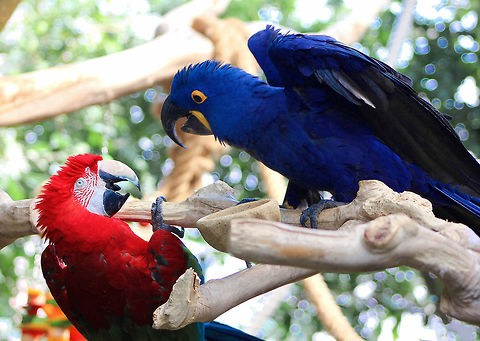
Appearance
The largest parrot by length in the world, the Hyacinth Macaw is 100 cm long from the tip of its tail to the top of its head and weighs 1.2–1.7 kg. Each wing is 388–425 mm long. The tail is long and pointed. Its feathers are entirely blue, lighter above and darker on its wings. It has a large black curved beak. It has a lappet of bright-yellow bare skin on the left and right of its face adjacent to the base of its lower beak and an eyering of yellow bare skin encircle each eye. Male and female are identical in external appearance, and juveniles resemble adults except they have shorter tails and the yellow on their faces is paler.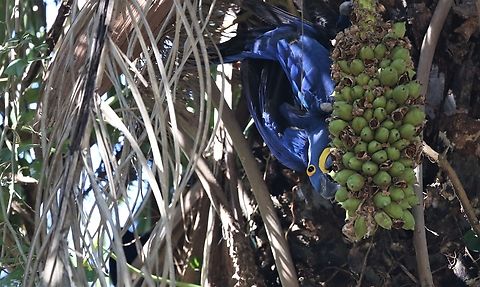
Distribution
The Hyacinth Macaw survives today in three main populations in South America: In the Pantanal region of Brazil, and adjacent eastern Bolivia and northeastern Paraguay, in the Cerrado region of the eastern interior of Brazil, and in the relatively open areas associated with the Tocantins River, Xingu River, Tapajós River, and the Marajó island in the eastern Amazon Basin of Brazil.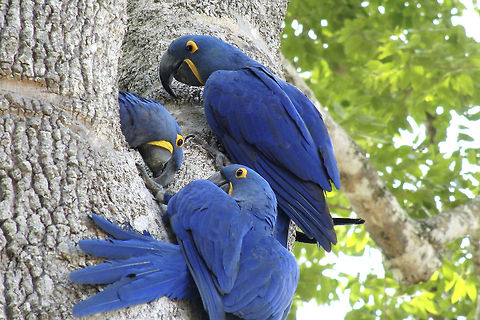
Status
The Hyacinth Macaw is an endangered species due to overcollection for the cage bird trade and habitat loss.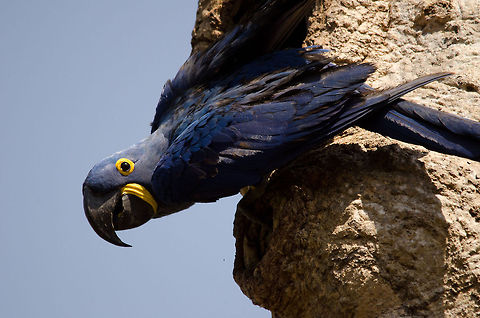
Habitat
It prefers palm swamps, woodlands, and other semi-open wooded habitats. It usually avoids dense humid forest, and in regions dominated by such habitats, it is generally restricted to the edge or relatively open sections. In different areas of their range these parrots are found in savannah grasslands, in dry thorn forest known as 'caatinga', and in palm stands, particularly the Moriche Palm.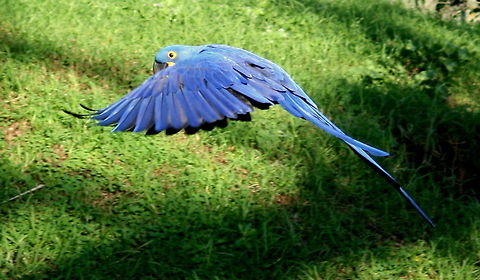
Reproduction
Nesting takes place between July and December, nests are constructed in tree cavities or cliff faces depending on the habitat. In the Pantanal region, 90% of nests are constructed in the manduvi tree. Hollows of sufficient size are only found in trees of around 60 years of age or older, and competition is fierce. Existing holes are enlarged and the partially filled with wood chips. The clutch size is one or two eggs, although usually only one fledgling survives as the second egg hatches several days after the first, and the smaller fledgling cannot compete with the first born for food. The incubation period lasts about a month, and the male will tend to his mate whilst she incubates the eggs. The chicks leave the nest, or fledge, at around 110 days of age, and remain dependent on their parents until 6 months of age. They are mature and begin breeding at seven years of age. Eggs are regularly predated by corvids, possums, coatis and toucans. Adults have no known natural predators. The young are parasitized by larvae of flies of the genus "Philornis".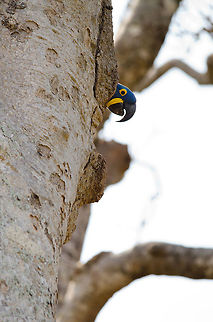
Food
The majority of the hyacinth macaw diet is nuts from native palms, such as acuri and bocaiuva palms. They have a very strong beak for eating the kernels of hard nuts and seeds. Their strong beaks are even able to crack coconuts, the large brazil nut pods and macadamia nuts.The acuri nut is so hard that the parrots cannot feed on it until it has passed through the digestive system of cattle. In addition, they eat fruits and other vegetable matter. Pine nuts are also one of the most popular foods.In the Pantanal, Hyacinth Macaws feed almost exclusively on the nuts of "Acrocomia aculeata" and "Attalea phalerata" palm trees.
References:
Some text fragments are auto parsed from Wikipedia.